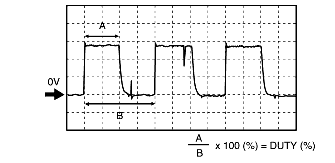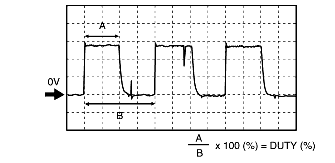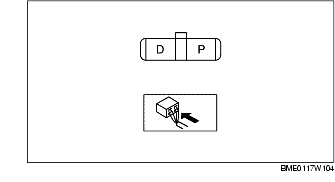GENERATOR INSPECTION [LF, L3]
id0117008003a4
-
Caution
-
• Do not apply direct battery positive voltage to the generator terminal D, otherwise it could cause damage to the internal parts (power transistor) of the generator.
Generator Warning Light
1. Verify that the battery is fully charged.
2. Verify that the drive belt deflection/tension is correct. (See DRIVE BELT INSPECTION [LF, L3].)
3. With the ignition switch at ON, verify that the generator warning light illuminates.
-
• If it does not illuminate, inspect the generator warning light and the wiring harness.
-
- If the generator warning light and the wiring harness are normal, inspect the PCM.
4. Verify that the generator warning light goes off after the engine is started.
-
• If it does not go out, inspect if any one of the following DTCs in the on-board diagnostic system are displayed: P0112, P0113, P2502, P2503, P2504. (See DTC TABLE [LF, L3].)
Generator
Voltage
1. Verify that the battery is fully charged.
2. Verify that the drive belt deflection/tension is correct. (See DRIVE BELT INSPECTION [LF, L3].)
3. Turn off all electrical loads.
4. Start the engine and verify that the generator rotates smoothly without any noise while the engine is running.
5. Measure the voltage at each terminal using a tester.
Standard specification
|
Terminal
|
IG-ON (V)
|
Idle (V) [20 °C {68 °F}]
|
|
B
|
B+
|
13.0-15.0
|
|
P
|
Approx. 1.0 or less
|
Approx. 3.0-8.0
|
|
D
|
Approx. 0
|
*
|
-
* :
Turn the following electrical loads on and verify that the voltage reading increases.
-
• Headlights
-
• Blower motor
-
• Rear defroster
Current
-
Note
-
• Since the charging current decreases rapidly after starting the engine, carry out the following procedure quickly, and read the maximum current value.
1. Verify that the battery is fully charged.
2. Verify that the drive belt deflection/tension is correct. (See DRIVE BELT INSPECTION [LF, L3].)
3. Disconnect the negative battery cable.
4. Connect a tester capable of reading 120 A or more between generator terminal B and the wiring harness.
5. Connect the negative battery cable.
6. Turn off all electrical loads.
7. Start the engine.
8. Increase engine speed to 2,500 rpm.
-
Note
-
• When the electrical load of the vehicle is low, specified current will not be verified although the generator is normal. In this case, increase the electrical load (by turning on the headlight and leave it for a while, then discharge the battery or by similar methods) and recheck.
-
• When the generator itself or the ambient temperature are too high, specified current will also not be verified. In this case, cool down the generator and recheck.
9. Turn the following electrical loads on and verify that the current reading increases more than the minimum value indicated below.
-
- If it is not as specified, go to PCM and generator shearing inspection. (See PCM and generator shearing inspection.)
-
• Headlights (high-beam)
-
• Blower motor (high)
-
• Rear window defroster
-
• Stop lamp
Minimum current
-
70 % of the nominal output current (nominal output current: 90 A)
-
[ambient temperature 20 °C {68 °F}, voltage 13.0-15.0 V, both engine and generator are cold]
PCM and generator shearing inspection
1. Inspect as follows:
|
Step
|
Inspection
|
Action
|
|
1
|
Measure the generator terminal B voltage when the electrical loads*1 are on and off.
|
15 V or more
|
Go to Step 2.
|
|
13-15 V
|
Normal*2
|
|
13 V or less
|
Go to Step 3.
|
|
2
|
Monitor the ALTTV PID using WDS or equivalent, or measure the voltage of PCM terminal 2AM using a tester. Is the voltage between 13 and 15 V ?
|
Yes
|
Go to Step 4.
|
|
No
|
PCM input error.
|
|
3
|
Monitor the ALTTV PID using WDS or equivalent, or measure the voltage of PCM terminal 2AM using a tester. Is the voltage between 13 and 15 V ?
|
Yes
|
Go to Step 5.
|
|
No
|
PCM input error.
|
|
4
|
Monitor the ALTF PID using WDS or equivalent, or calculate the duty value of the PCM terminal 2AQ using oscilloscope. Is the duty value 100 % ?
|
Yes
|
PCM input error.
|
|
No
|
PCM, generator, or both are not normal.
|
|

|
|
5
|
Monitor the ALTF PID using WDS or equivalent, or calculate the duty value of the PCM terminal 2AQ using oscilloscope. Is the duty value 0 % ?
|
Yes
|
PCM input error.
|
|
No
|
PCM, generator, or both are not normal.
|
|

|
-
*1 :
Headlights, blower motor, rear window defroster, and stop lamp.
-
*2 :
If the generator field coil duty value does not change when electrical loads (such as headlights, blower motor, rear window defroster, stop lamp) are on or off, inspection with discharged battery is needed.
